|
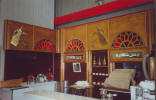 The Mecca
of Mocha The Mecca
of Mocha
By
Krista Henning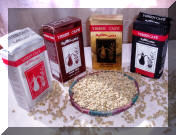
Woe
betides the coffee snob who cannot
distinguish between a caffe latte and a café
au lait. Imagine the shame of confusing Kalossi with Kona, or
Celebes
with your humble Columbian. Even the
well-informed may not know that Mocha is a
generic term for several aristocratic Yemeni
coffees, not just a coffee house cocktail.
Before
taking a friend’s two teenage daughters to
school, I stop at Coffee Heaven where the
girls order a Quad Kahlua Kicker: two double
shots of espresso with vanilla, Irish cream,
and steamed milk sprinkled with chocolate.
Other coffee drinks are just as exotic.
There is the 911: espresso topped with house
coffee. The Redneck Latte: house coffee with
two sugars, whipped cream, and chocolate
sprinkles. How about an 000: decaf skinny
Latte. New Age Rice Dream Mocha: non-dairy
brown rice beverage with powdered chocolate
and a single or double espresso.
Mocha is
an old port in
Yemen
. In the sixteenth century, exports from
Mocha included fruits, cloth, spices, dyes,
pottery, and most importantly, coffee, grown
in the Yemeni mountains – the latest craze
in
Europe
. Soon after the English and Dutch built the
first coffee factory in Mocha, other
Europeans followed and even some Americans.
During that time
Yemen
had a world monopoly on coffee beans and the
country prospered. Eventually, however, the
plant was smuggled out of the country to
Ceylon
(
Sri Lanka
) and Java, hence, Mocha-Java.
Another
story tells of the Portuguese seaman who
anchored off the shores of Mocha where the
local Sheik greeted them with an
invigorating and stimulating effect of the
drink. They requested sacks of the green
beans to take home and thus, the story goes,
the monopoly was finally broken as the
coffee bean started to grow in other parts
of the world.
When the
original Mocha bean was transplanted, it
mutated, adapted, became bastardized, and so
only resembles the delicate grandeur of the
original.
"Jamaican
Blue
Mountain
has the name, but we in
Yemen
have the flavor,” says Mr. Kaid, owner of
the only coffee factory in all of
Yemen
. The home of the original coffee bean is
waiting to be rediscovered.
Yemen
is one of the world’s oldest inhabited
regions. Here the Queen of Sheba started her
long journey across the
Arabian Peninsula
to meet King Solomon in the north. Early
explorers such as Marco Polo visited
Yemen
, known then as “Arabia Felix,” where
frankincense, myrrh, and Mocha coffee
brought worldwide fame to
Yemen
. Legend has it that after consuming
quantities of this brew, Marco Polo sped off
to discover spaghetti.
The
Yemeni coffee boom reached its climax at the
beginning of the 18th century.
Prices had risen so much that the European
powers were now trying to contravene the
export embargo on the coffee plant and grow
coffee in their own colonies. The Dutch
succeeded first, around 1720 in Java,
followed by the French in the
West Indies
. Later a number of other coffee growing
countries started to grow the Mocha-derived
coffee beans much more cheaply and in larger
quantities.
By
the middle of the 19th century,
Yemen
supplied only 1 percent of the world coffee
production. Since then
Yemen
’s chief agricultural product has been
quat, which has replaced some of the income
lost from their dying coffee industry. This
evergreen (Catha edulis and Catha spinosa)
is cultivated for its shoots and chewed as a
stimulant. It is grown interspersed with
coffee trees in plantations.
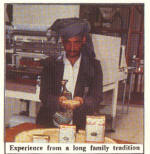 The
restoration of the coffee trade is on many
Yemeni’s minds. They want to see the mocha
coffee plants fill the mountains once more
and get rid of what some call “Satan’s
green leaves.” This is exactly what Mr.
Kaid and his families are doing. Their
coffee beans come from the fertile terraces
of the Western Yemeni mountains, which reach
elevations of more than 9.000 feet. The
restoration of the coffee trade is on many
Yemeni’s minds. They want to see the mocha
coffee plants fill the mountains once more
and get rid of what some call “Satan’s
green leaves.” This is exactly what Mr.
Kaid and his families are doing. Their
coffee beans come from the fertile terraces
of the Western Yemeni mountains, which reach
elevations of more than 9.000 feet.
As
in the past, the best coffee is grown there
on rain-fed terraces. The method of
cultivating is still the same as it was 300
years ago. The soil is prepared by hand, and
each tree is taken care of individually
using stone mulch.
“Our
family has a long-standing tradition in
selecting and treating coffee beans. We
combine traditional methods with modern
machinery. This is our family’s secret and
why the aroma of our coffee beans is
outstanding among all coffee brands,” says
Mr. Kaid. Today their coffee is exported to
France
,
Germany
, and
Italy
.
“What
about
America
?” I asked.
“
America
? Americans are not familiar with our
coffee; they don’t even know that my
country exists. Americans run around all day
with a gigantic Styrofoam cup filled with
sludge,” he sneered.
“Haven’t
you heard of the New Age Dream Mocha?” I
responded.
To
the world’s first coffee drinkers, the
Middle Eastern Muslims, coffee was the
“Wine of the Apollo.” It was their
counterpart to the pagan wine of Dionysus,
and ecstasy. Today’s Western coffee
connoisseurs critique an excellent coffee
with the same exactitude as a vintage wine.
And
what is the best coffee?
According
to the Kobos Coffee Company, the most exotic
coffees are
Jamaican
Blue
Mountain
, Kona, and Yemeni. How is the Yemeni coffee
selling?
“It
sells very slowly; most people have never
heard of it,” said David, from Coffee
Corner Limited.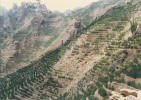
Allen
Brothers responded, “
Yemen
? Never heard of it.”
I
asked the Good Bean Company, “Do you
consider your shop to be a gourmet coffee
outlet?”
“Absolutely!
We carry coffee beans from all over the
world,” Matt answered. “Do you have
Yemeni coffee beans?” I’ve never heard
of them,” he responded.
“What
is the most exotic coffee you carry?” I
continued.
“I
really couldn’t tell you. That is
proprietary information.”
Is
this the wave of the future? Will coffee
information become the new currency of
international espionage?
Americans,
whose revolutionary history is founded on an
argument about tea, might be expected to wax
passionate on the subtleties of the mighty
Mocha.
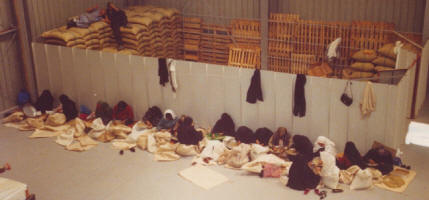
|

